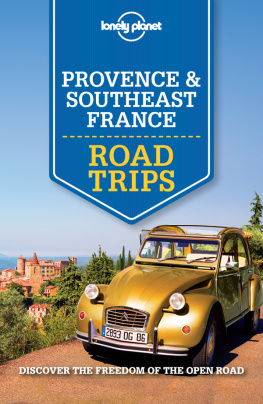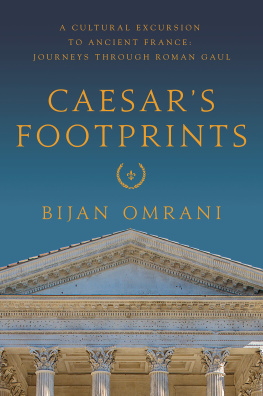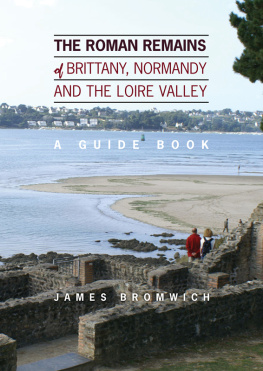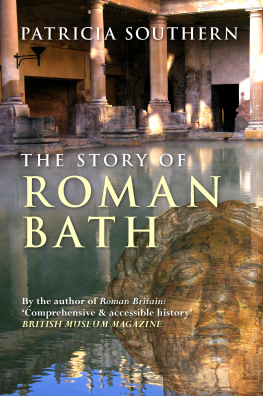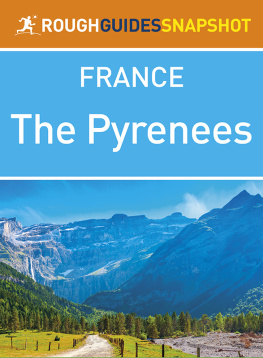THE ROMAN REMAINS OF
SOUTHERN FRANCE
THE ROMAN
REMAINS OF
SOUTHERN FRANCE
A guidebook
JamesBromwich

First published 1993
First published in paperback 1996
by Routledge
2 Park Square, Milton Park, Abingdon, Oxon, OX14 4RN
Simultaneously published in the USA and Canada
by Routledge
270 Madison Ave, New York NY 10016
Transferred to Digital Printing 2005
Routledge is an International Publishing company
1993, 1996 James Bromwich
Typeset in 10 on 12 point Garamond Linotronic 300 by
Florencetype, Weston-Super-Mare, Avon
All rights reserved. No part of this book may be reprinted or reproduced or utilized in any form or by any electronic, mechanical, or other means, now known or hereafter invented, including photocopying and recording, or in any information storage or retrieval system, without permission in writing from the publishers.
British Library Cataloguing in Publication Data
A catalogue record for this book is available from the British Library
Library of Congress Cataloguing in Publication Data
A catalogue record for this book has been requested
ISBN 0415-143586
CONTENTS
Alba Bourg-Saint-Andeol- Die Valence Vienne Other sites in the lower Rhne
Agde Ambrussum Beaucaire Bziers Carcassonne Chteau-Roussillon Ensrune Lattes Les Clusesl Le Perth us Loupian Narbonne Nmes Pont du Gard Other sites in Languedoc-Roussillon
Aix-en-Provence Apt Aries Avignon Barbgal- Carpentras Cavaillon Istres La Couronne Le Pont Julien Marseille Moulin des Bouillons Orange Roquepertuse St Blaise- St Chamas St Rmy-de-Provence (Glanum) Vaison-la-Romaine Verngues Other sites in central Provence
Antibes Frjus Hyres La Turbie Lerins Islands Mons- Nice Riez Sisteron Other sites in eastern Provence
FIGURES
PLATES
Between pages 125 and 126
PREFACE
The origins of this book lie in the bookshops and bars of southern France. Why was there so often that look of incomprehension, or shrug of the shoulders, if we asked for a guidebook that identified and described the majorand possibly some of the minorRoman sites? After all, France had been part of the Roman Empire, and Roman civilisation had made an even deeper impact than in Britain. Yet there seemed to be nothing. There were general books, in both French and English; there were individual guides to a limited number of sites which were only available at or near the places they were describing; but no book that attempted to introduce the whole region to the interested traveller.
At first frustration simply led to another sip of wine, but the answer gradually emerged as we discussed the situation. Holidays became research events: discovering and visiting sites and museums, pursuing obscure references to books, articles, prints or photographs, and meeting people.
How do you find sites when there is no guidebook? Initially it seemed unlikely that there would be a problem; the general works on the Gallo-Roman era are distillations of knowledge drawing heavily on evidence from the remains. However, an important archaeological site has not necessarily left much to be seen, indeed some have left nothing at all. It was not always clear from the reading that the excavation which led to fascinating revelations was followed by the construction of a block of flats or that the site was afterwards abandoned and is now totally overgrown. My son, then 13, has never forgotten the tattered and dismal excavation remains of the second best villa in France (not included in this book!).
It is, then, people on whom I have depended. The chance meeting at the roadside that led me to a Roman aqueduct hidden in the countryside; the assistance from museum curators, often so willing to help me with my awkward stumbling enquiries, and most of all, the archaeologists. The encouragement given by the enthusiastic replies of K. D. White on Roman olive mills and R. Agache on aerial photography were fundamental in the early stages. The kind help I received from the Regional Director and his assistants in Aix-en-Provence was vital. I would like to thank particularly Chrine Gbara, the municipal archaeologist at Frjus, who opened my eyes to what could be seen. Some of my most appalling Latin errors have been removed due to the generously given advice of Mark Hassall at University College, London. Librarians at the Institute of Archaeology (University College) and those of the Institute of Classical Studies have been consistently sympathetic. Without Tim Pooley (London Guildhall University) and his vital contributions, my written communications would have been dramatically poorer.
The drawings used to illustrate the text can rarely claim much originality, but I am responsible for the versions presented here. They embody what I have chosen to includeand exclude. However, they could not have been done without the crucial assistance of Edward Oliver and John Wilson, who actually drafted the majority of the maps and plans.
Lastly I would like to thank family, friends and colleagues. They have provided ideas, reassurance and tolerance for an increasingly one-track mind. Despite the second best villa, my son, Stephen, has collected map references, whilst my wife, Anne, has not only given me constant encouragement (amazing when I consider my obsessiveness), but also read everything I have written, pointed out faulty English, corrected many of my spelling errors and, perhaps most important of all, advised me when I seemed to be losing sight of the interested traveller.
INTRODUCTION
There is much pleasure to be found in the south of France: the blend of soft colours and powerful sun, the flowers and the twists of the olive trees, the vineyards and the stark rocks impart a warm glow to places like the Pont du Gard and help to create an immediate sense of the pasteven more vividly in less visited sites like the temple ruins at Verngues. I think though it is possible to get more. Only destruction, insensitive modern building and sometimes reconstruction can destroy our intuitive sense of the past; greater knowledge cannot. Just as a geologist can open our eyes to the physical environment, I hope I can add some meaning for visitors to the remains of what the French describe as la civilisation gallo-romaine.
This guidebook is not an academic study, but it draws on what academics are doing. One of the excitements of visiting the amphitheatre at Aries is the possibility of understanding it in so many different ways: an awareness of the kind of activities that went on there; who sat in the seats and where, what made people want this kind of entertainment; the structural and architectural choices made by the builders; the changes that occurred during the Roman period and after; the different approaches adopted by archaeologists and the kinds of questions they ask themselves. Knowing more about these will not stop you sitting at the top and looking down into the arena and imagining the gladiators, nor will it stop you looking out across the river or to the more distant mountains, the same views experienced nearly 2,000 years ago; it can only enhance the imagination.




